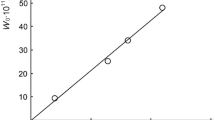Abstract
Experimental data on the unimolecular degradation of structurally different alcohols, alkanols into water and an olefin and alkenols into a carbonyl compound and an olefin, were analyzed in terms of the method of crossing parabolas. The kinetic parameters characterizing such decomposition were calculated and factors that affect the activation energy of the reaction (the cycle strain energy, the steric factor, and the effect of π electrons neighboring the reaction center) were determined. The activation energies and the rate constants were calculated for 30 alcohol degradation reactions. The enthalpies, the activation energies, and the rate constants of degradation of unsaturated alcohols were compared for two different degradation routes yielding a carbonyl compound and an olefin or resulting in water and an olefin. Quantum-chemical calculations of the transition states for three model reactions were performed. The activation energies and the rate constants were obtained for the first time for 13 reverse reactions of the addition of carbonyl compounds to olefins.
Similar content being viewed by others
References
N. N. Semenov, Selected Works, vol. 4: Some Problems in Chemical Kinetics and Reactivity (Nauka, Moscow, 2004) [in Russian].
Comprehensive Chemical Kinetics: Decomposition and Isomerisation of Organic Compounds, Ed. by C. H. Bamford and C. F. H. Tipper (Elsevier, Amsterdam, 1972), Vol. 5, p. 443.
T. S. Pokidova and E. T. Denisov, Neftekhimiya 46(2), 100 (2006) [Pet. Chem. 46, 84 (2006)].
T. S. Pokidova and E. T. Denisov, Khim. Fiz. 25(6), 33 (2006).
E. T. Denisov, Usp. Khim. 66(10), 953 (1997).
E. T. Denisov, Usp. Khim. 69(2), 166 (2000).
E. T. Denisov, in General Aspects of the Chemistry of Radicals, Ed. by Z. B. Alfassi (Wiley, London, 1999), p. 79.
E. T. Denisov, T. G. Denisova, and T. S. Pokidova, in Handbook of Free Radical Initiators (Wiley, Hoboken, 2003).
A. F. Shestakov, E. T. Denisov, and N. S. Emel’yanova, Izv. Akad. Nauk, Ser. Khim., No. 4, 886 (2005)
I. V. Aleksandrov, Teor. Eksp. Khim., No. 12, 299 (1976).
NIST Standard Reference Database 19A. Positive Ion Energetics. Version 2.02 (Gaithersburg, 1994).
E. S. Domalski, J. Phys. Chem. Ref. Data 2, 805 (1993).
A. B. Trenwith, J. Chem. Soc. Faraday Trans. 1 71, 2405 (1975).
W. Tsang, J. Chem. Phys. 40, 1498 (1964).
E. A. Dorko, D. B. McGhee, C. E. Painter, et al., J. Phys. Chem. 75, 2526 (1971).
D. Lewis, M. Keil, and M. Sarr, J. Am. Chem. Soc. 96, 4398 (1974).
C. G. Newman, H. E. O’Neal, M. A. Ring, et al., Int. J. Chem. Kinet. 11, 1167 (1979).
W. Tsang, Int. J. Chem. Kinet. 8, 173 (1976).
G. G. Smith and B. L. Yates, J. Chem. Soc., 7242 (1965).
R. August, I. McEwen, and R. Taylor, J. Chem. Soc., Perkin Trans. 2, No. 11, 1685 (1987).
J. Gonzalez-Vazquez, A. Fernandez-Ramos, E. Martinez-Nunez, and S. A. Vazquez, J. Phys. Chem., A 107, 1389 (2003).
S. D. Peterson and J. S. Francisko, J. Phys. Chem., A 106, 3106 (2002).
X. F. Duan and M. Page, J. Am. Chem. Soc. 117, 5114 (1995).
P. Sanchez-Anrada, I. Alkorta, and J. Elguero, J. Mol. Struct. (THEOCHEM) 544, 5 (2001).
M. J. Frisch, G. W. Trucks, H. B. Schlegel, G. E. Scuseria, M. A. Robb, J. R. Cheeseman, V. G. Zakrzewski, J. A. Montgomery, Jr., R. E. Stratmann, J. C. Burant, S. Dapprich, J. M. Millam, A. D. Daniels, K. N. Kudin, M. C. Strain, O. Farkas, J. Tomasi, V Barone, M. Cossi, R. Cammi, B. Mennucci, C. Pomelli, C. Adamo, S. Clifford, J. Ochterski, G. A. Petersson, P. Y. Ayala, Q. Cui, K. Morokuma, D. K. Malick, A. D. Rabuck, K. Raghavachari, J. B. Foresman, J. Cioslowski, J. V. Ortiz, A. G. Baboul, B. B. Stefanov, G. Liu, A. Liashenko, P. Piskorz, I. Komaromi, R. Gomperts, R. L. Martin, D. J. Fox, T. Keith, M. A. Al-Laham, C. Y. Peng, A. Nanayakkara, C. Gonzalez, M. Challacombe, P. M. W. Gill, B. Johnson, W. Chen, M. W. Wong, J. L. Andres, C. Gonzalez, M. Head-Gordon, E. S. Replogle, and J. A. Pople, Gaussian 98, Revision A.7 (Gaussian, Pittsburgh, 1998).
D. Stull, E. Westrum, and G. Sinke, The Chemical Thermodynamics of Organic Compounds (Wiley, New York, 1969; Mir, Moscow, 1971).
Author information
Authors and Affiliations
Corresponding author
Additional information
Original Russian Text © T.S. Pokidova, E.T. Denisov, A.F. Shestakov, 2009, published in Neftekhimiya, 2009, Vol. 49, No. 5, pp. 363–373.
Rights and permissions
About this article
Cite this article
Pokidova, T.S., Denisov, E.T. & Shestakov, A.F. Kinetic parameters and geometry of the transition state in the unimolecular degradation of alcohols. Pet. Chem. 49, 343–353 (2009). https://doi.org/10.1134/S0965544109050016
Received:
Published:
Issue Date:
DOI: https://doi.org/10.1134/S0965544109050016




